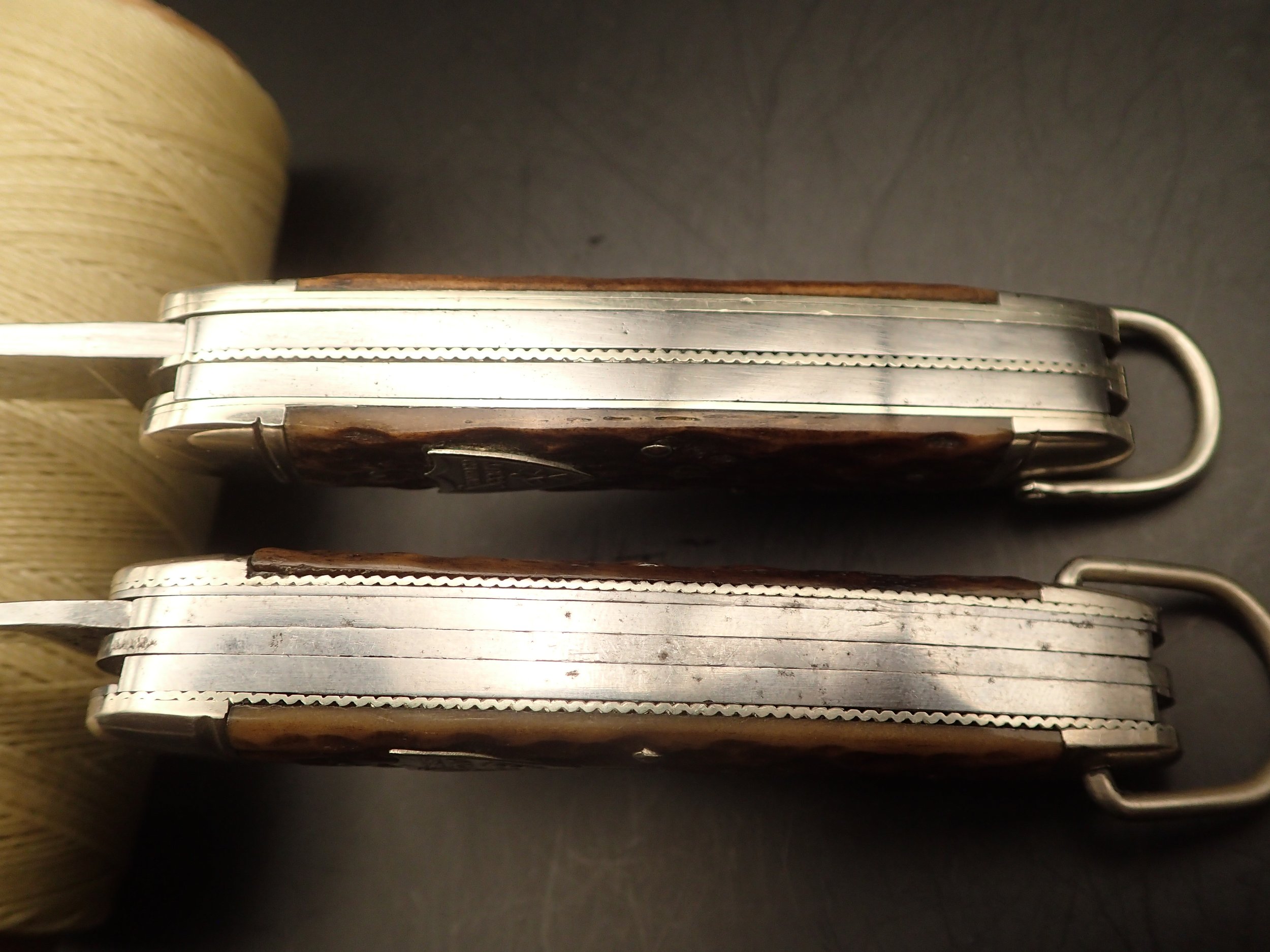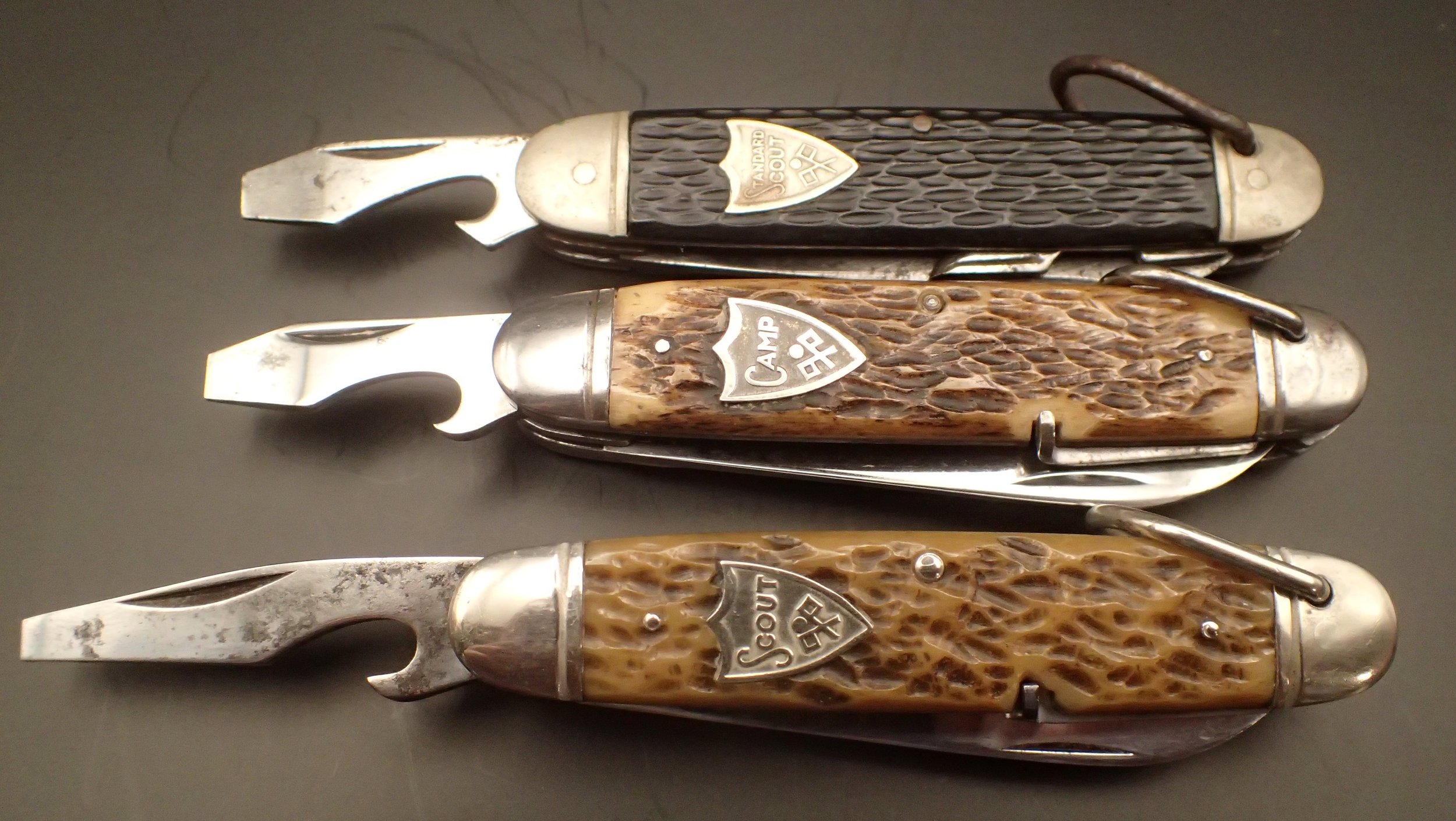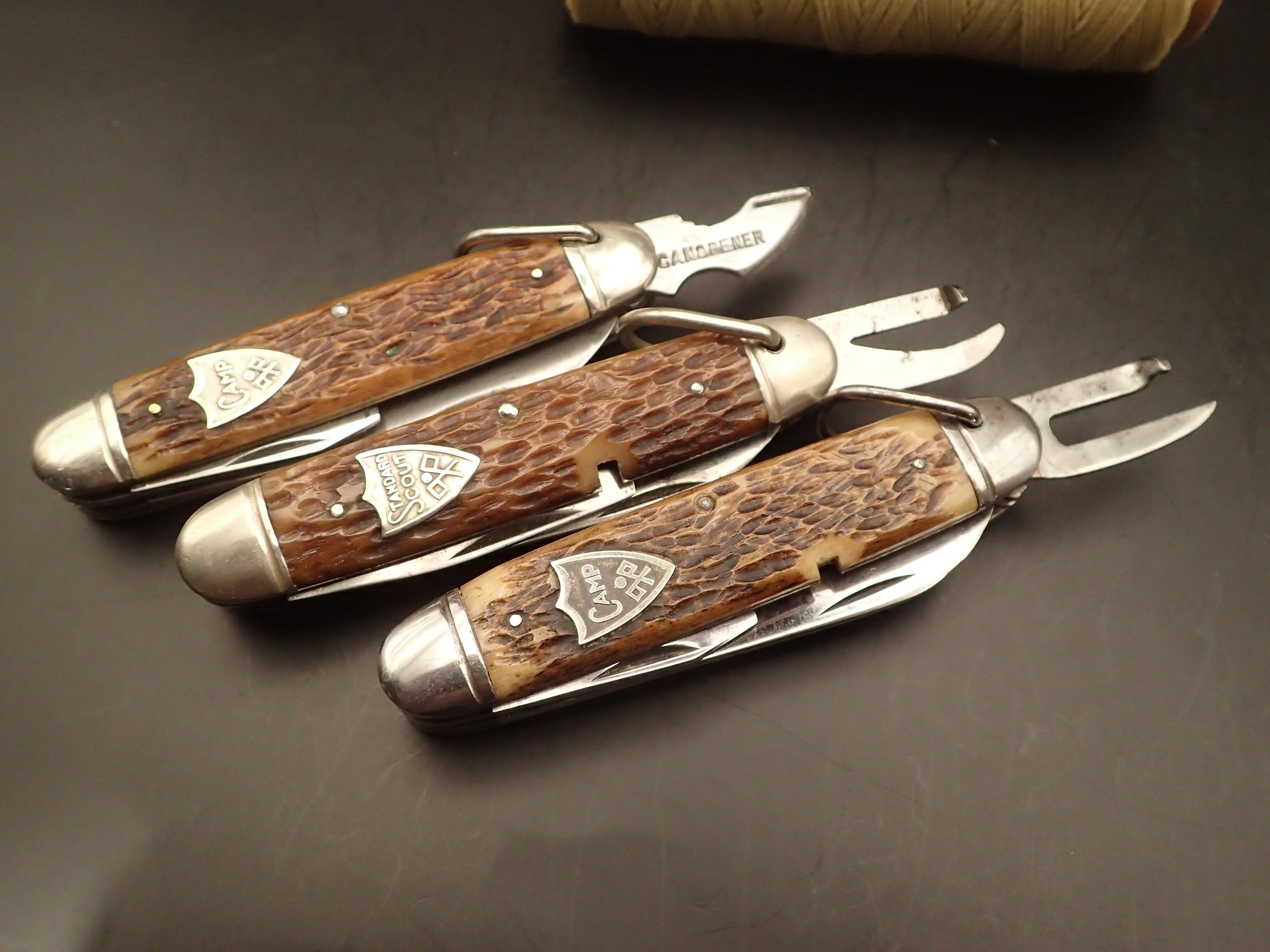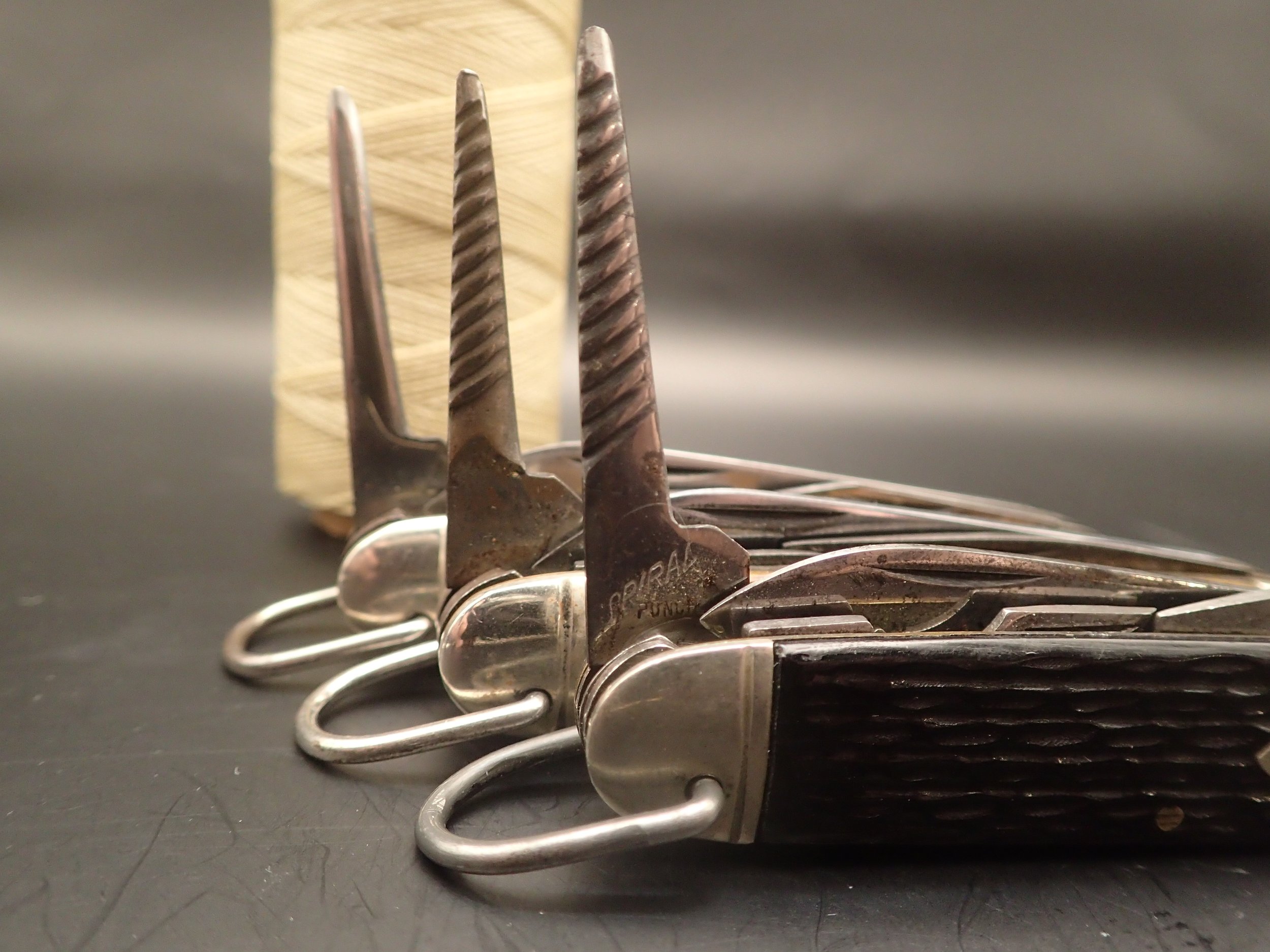Darmok, With Flags Unfurled! Collecting the Camillus Semaphore Scout Knives of the 1920's-40's.
Myron Erickson
Ok, with apologies to Star Trek: The Next Generation, I just couldn’t help myself, so let me back up a little and explain. “Darmok” is perhaps my favorite Next Gen episode, and introduces us to Dathon, the captain of an alien ship who speaks only in metaphor. Some of his more famous metaphors have become memes, but I won’t quote them here; follow the link if you’re curious. At any rate, it takes Captain Jean-Luc Picard most of the entire episode to solve this riddle, and for some reason it seems like something Dathon might have said when he was trying to infer that Picard could use a scout/utility knife to open his beer — “Darmok, with flags unfurled!” (I thought this was quite clever of me, but I Googled it before publishing this article and it turns out someone else had the same idea.)
In an imagined STNG scene, the Tamarian Dathon is signaling to Jean-Luc Picard using semaphore flags. Image compliments Murphs33@Imgur.
But to get us back on topic, from the 1920’s into the 1980’s, 400-plus years before STNG is set, the market for 4-blade scout/utility knives was a strong one in the United States, with more than a dozen American manufacturers and at least as many German cutlers all providing the same basic product and vying for market share. As you have found yourself at my blog, this surely doesn’t come as news.
In addition to articles about collecting the Victorinox Pioneer/Model 1961, I’ve written about the Case 6445R, the Boker USA 9361, and the Camillus 1760. Today I want to write about another American-made 4-blade scout/utility knife that I think is often overlooked by many collectors. It was sold under a large number of brand names, and appeared in a few varieties, but all of these knives were produced by Camillus and had one thing in common, their semaphore shield.
Shields of the semaphore scouts.
If you Google it, you won’t find any references to “semaphore scout knives,” but this is what we should all be calling them because they all share the same charming trait, which is a federal-style shield with a pair of crossed semaphore flags and any of a number of scout- or camp-related names above the flags. These were not officially licensed BSA products, which are collectible in their multitudes and for their own reasons. Rather, these knives were designed to appeal not only to Boy Scouts and Girl Scouts, but also to outdoorsmen, campers, tradesmen, and any handy person who liked to carry a utility pocket knife. Like my grandmother, for example.
More shields of the semaphore scouts.
The range goes from very basic models with steel blades and liners, no decorative touches, metal shell scales, and removable bails to relatively deluxe models with stainless steel blades, brass liners, coin-edge decoration, fixed bails, and premium branding — and everything in between. The scout pattern collector who enjoys minutiae, what I call the oxymoronic pursuit of finding variety within homogeneity, has plenty of opportunity with the semaphore scouts. And then there’s that incredible shield.
Note the coin edge details and heavy duty tool and spring stock in these two specimens.
Brands.
To the best of my knowledge, Camillus produced all these knives, and they did so under a variety of brand names, leaving a wide hunting field for the collector today. The brands in my collection, as evidenced by tang stamps and blade etches, include:
Clover
High Carbon Steel
Fairmount
Sword Brand
Hibbard, Bartlett, Spencer & Co
Sta-Sharp
Craftsman
Stainless Cutlery Co
High Carbon Steel
Keen Kutter
The semaphore scouts were offered under a wide variety of brand names.
Shields! (As Hikaru Sulu might have said.)
Across the ten brands in my small collection of semaphore scouts, there are five different shields represented, and I’ve seen at least two other shields on knives in other collections. Some shield variants are easy to find, while some are quite rare in my experience. I wish I could tell you that, as with the Model 1961 Soldier SAK, the shield dates the knife. But I don’t know this, and I think it’s likely that the different shield variants were sold concomitantly. In addition, some cheaper models were made with printed semaphore shields, as opposed to the fancier, more durable shields made of nickel silver and pinned onto the scale. As you might expect, the printed shields haven’t fared as well. The shield variants in my set are:
Standard Scout (common)
Stainless Scout (rare)
Scout (common)
Camp (less common)
Signal Knife (ultra rare)
Shield variety. From L to R: Standard Scout, Stainless Scout, Scout, Camp, Signal Knife.
Scale Materials, Bolsters, Bails.
My semaphore scout knives reflect a variety of scale materials, which doesn’t seem to correlate to which shield they wear. For example, I have Standard Scout shields in pearlescent celluloid (rare), jigged-look black composite (very common), smooth black composite (common, and commonly trashed), and beautifully jigged bone (common). My Signal Knife, which appears to be among the older knives in my group, uses metal shell scales.
Metal shell scales on the Signal Knife semaphore scout.
The bolsters on my knives are lined, perhaps the one thing they all have in common besides their shield design. And they all have either a fixed or removable bail, located at the bottom end of the knife where the blade can accidentally be closed on it. The shield is almost always located at the top end of the knife, opposite the bail, yet the shield’s location is sometimes reversed and placed at the bottom end of the knife on the bail’s end. One wonders how Dathon could use this example — perhaps “Darmok, with shield reversed!” to indicate a fault with the ship’s, um, shields?
All Standard Scouts, yet one apparently has a non-standard shield orientation.
Blade Etches.
The only two varieties of semaphore scout I’ve encountered with a blade etch are the Sta-Sharp, which was sold by Sears, Roebuck & Co., and the Stainless Cutlery Co., which was one of Camillus’ own brands. Later, I’ve read 1942, the Sta-Sharp was re-branded as a Craftsman, with the Sta-Sharp branding remaining on the etch but taking a back seat to the Craftsman trademark.
Sta-Sharp 9548’s as sold by Sears in the late 1930’s (top) and early 1940’s (bottom).
The Stainless Scout has the added bonus of including the semaphore shield on the etch itself, and, go figure, one of my Sta-Sharp knives has a blade etch that says “Standard Trooper.”
Stainless Scout (top) and rare Standard Trooper (bottom).
Tools & Implements.
The semaphore scouts all follow the basic 4-blade American scout/utility pattern with spear point blade & awl/punch in one layer, and cap lifter/screwdriver & can opener on the other layer. But there is variety in the implements, springs, and liners the collector will want to look out for: three different can openers, three different cap lifters, three different awl/punches, and wide variation in tool and spring stock thickness. And, as already mentioned, decorative coining on liner edges pops up now and then.
Variety of spring thickness, liner material, and decoration.
Collectors will encounter three distinct cap lifters, two short versions and a long one. One of the short tools has the sharper-chinned design seen on other Camillus knives from this period, while the other is a little softer and lacks the sharp chin. I can find no correlation between the style of cap lifter on any given knife and its style of can opener or awl. It seems to have been somewhat mix-and-match.
Cap lifters: sharp-chinned short (top), smooth-chinned short (middle), and long (bottom).
The earlier knives have either the top-opening plunge-style or the side-opening scythe-style can opener. I spent a lot of time researching which one of these may have come first in time, assuming that I was investigating an evolutionary process. But my conclusion is that both implements were in use at the same time, and that Camillus made knives with both styles of opener from the 1910’s through the 1930’s. If you are a Camillus collector and know the answer to this riddle, please get in touch. We can date with more certainty knives that use Camillus’s so-called u-shaped scythe-style can opener, which appeared and was in use on the semaphore scouts in the mid-to-late-1940’s. I have never seen a semaphore scout with a Camillus two-piece can opener (which itself was used more on the Boker USA 9361) or a Mirando-style safety can opener.
Can openers: top-opening plunge (top), side-opening scythe (middle), u-shaped side-opening scythe (bottom).
Collectors will also see three different styles of awl/punch in use on the semaphore scouts, which, again, don’t seem to correlate to either the style of can opener or cap lifter used. The awl/punch implement occurs in three styles: plain, spiral with no marking, and spiral identified as “Spiral Punch.” My gut tells me that the spiral punches are older, but I don’t know this for a fact.
Variation in the awl/punch implements.
Dating the Semaphore Scouts.
I think it entirely likely that the semaphore scouts originated in the late 1920’s. Camillus introduced the Sta-Sharp, High Carbon Steel, and Made in the USA brands/tang stamps in 1927. Their Stainless Cutlery Co. brand first appeared in 1924, just at the dawn of this material’s use in pocket knife applications, and the Sword Brand model 4006 dates to ca. 1930, as is likely for the Fairmount brand. One excellent resource I can point potential collectors to is Hobie Farmer’s YouTube reviews on the composite-scaled semaphore Scout and the Stainless Scout. He is a collector you can trust, who does his homework and doesn’t just repeat urban legends.
The other significantly unknown thing about these knives is how long they persisted. I would love to discover evidence of these knives being produced into the 1950’s, but I have not. Camillus’s u-shaped can opener was introduced before the end of WWII, but in 1944 they introduced the two-piece straight edge can opener, and after that the one-piece Mirando-style can opener was used. Alas, I have never seen a semaphore knife with either of these implements.
Conclusion.
I wish I knew more about the semaphore scouts. I’m used to being able to research what I write about, assimilate what I learn from others with what I can observe in my own collection, and draw some logical conclusions to tell a story. But, although there is plenty written about Camillus knives generally, I couldn’t find much on the Camillus semaphore scout/utility knives specifically. So my article here is really just a guide to what other collectors or those interested may encounter. If you know something about these knives, please get in touch.
I love hearing from readers and welcome your comments and factual corrections. Please leave your thoughts below, and thanks for reading.














